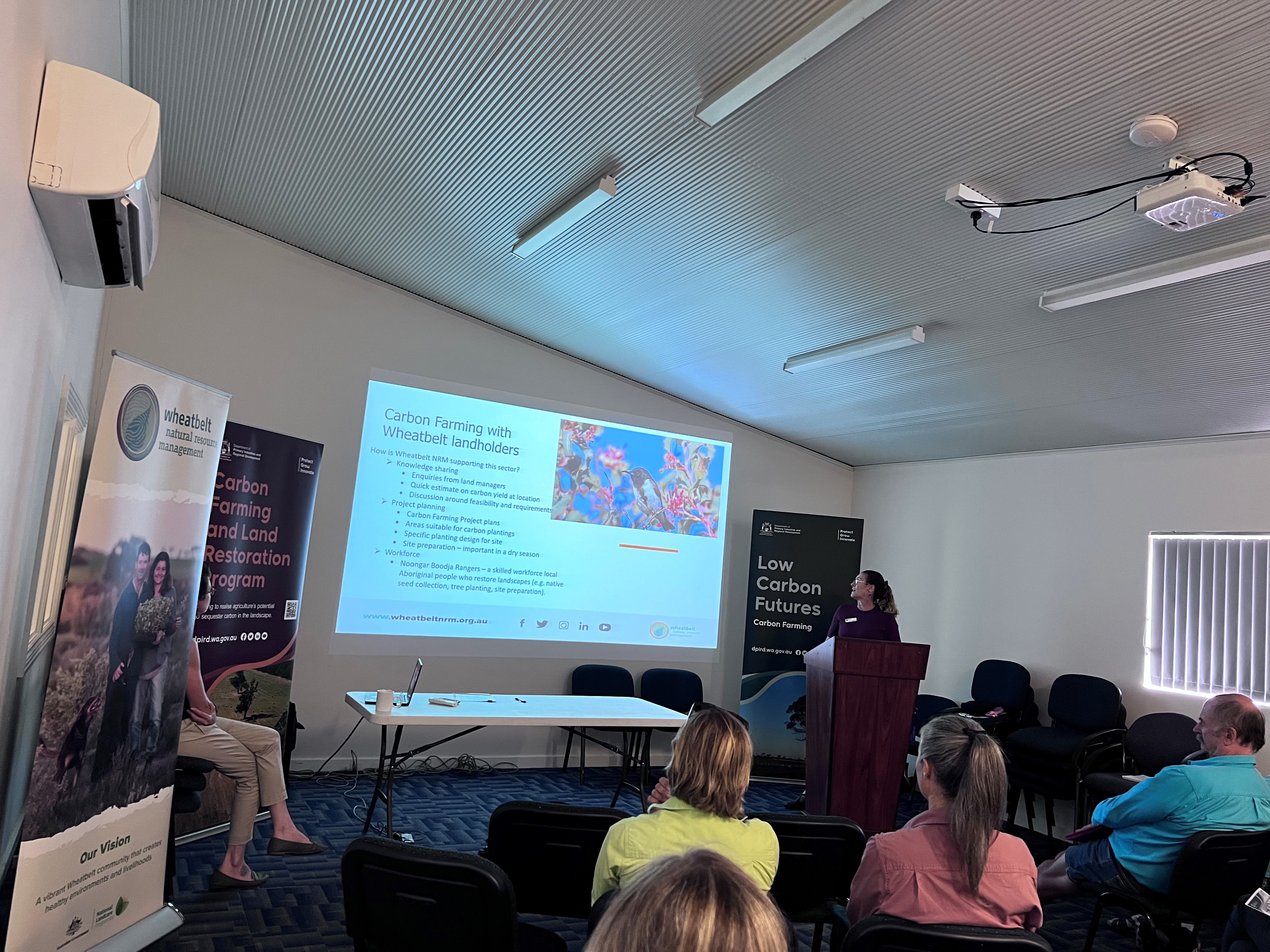Carbon Farming
It’s been a tough season for many, with 2023/24 throwing a few curved balls politically and climatically. Producers are understandably focused on core business, yet the global market environment continues to shift towards demonstrating emissions reduction both within the farm business and across the supply chain.
One way to help achieve carbon neutrality, particularly in the agricultural sector, is to actively sequester carbon in the landscape. Wheatbelt NRM have been building our knowledge base on carbon farming by contributing to key industry events and working with early-adopter landholders. By providing independent advice about carbon project requirements Wheatbelt NRM is helping landholders navigate these important nuances within their business landscape.
Operating on a fee-for-service basis, Wheatbelt NRM can help landholders plan native vegetation projects that generate Australian Carbon Credit Units (ACCUs) in several ways, including:
· Choosing the most suitable sites on each property to revegetate for ACCU generation and co-benefits
· Developing planting designs that meet Clean Energy Regulator method requirements and maximise biodiversity values
· Site preparation in a dry season with a short planting window – to set the project up for success
· Providing ecological and planting advice to carbon project developers who require specific regional knowledge and expertise.
Does it align with the Avon Region’s NRM Plan?
Another point of discussion is that ACCU-generating projects are required, upon registration with the Clean Energy Regulator, to demonstrate that they align with their Regional NRM plan. Generally speaking, if the project protects, restores or enhances the environment, boosts landscape resilience, and protects the resilience and cohesion of our rural communities, it will align with the Wheatbelt’s Regional NRM plan.
However, there are some planning issues to consider, particularly for larger-scale carbon farming revegetation projects, for example considering proximity to high-value groundwater resources, local government planning policies, or nearby population growth areas.
Co-benefits or core benefits?
Projects can also be planned to maximise the co-benefits aka ‘core benefits’ such as biodiversity and conservation, salinity management, wind erosion management, and other production benefits. Demonstrating co-benefits by documenting how the project affects farm productivity (yields) and by monitoring flora/fauna/erosion/salinity management associated with a carbon project, increases the market value of the project’s ACCUs, particularly in the case of biodiversity. Involving Traditional Owners in project development and implementation on Country (e.g. tree planting, native seed collecting or fauna monitoring) enhances the intrinsic core benefits of an already valuable landscape restoration activity.
Biodiversity value can be maximised by ensuring that block or belt plantings are more than 20 meters wide (where possible) and that revegetation occurs adjacent to, or connecting existing high-value remnant vegetation, nature reserves, and along waterways and rivers. Using locally occurring species and including all vegetative canopy layers helps build valuable habitat for native fauna.
Which leads to…Natural Capital Accounting
Having systems in place that can demonstrate changes in natural asset condition for a carbon farming project takes us on a journey towards natural capital accounting – aimed at improving business decisions around future production and Landcare investments.
When making changes to production systems, for example, changing inputs to actively improve biological soil health, it’s important to track progress and know what has changed in the soil, so that decisions can be made to adjust activities with optimal timing. This is, of course what farmers do best and is, in essence, nothing new.
Yet how we document this, such as in the form of a natural capital account, can make a difference to future opportunities. Analysing the costs and benefits (yields and ecological data) in the farm accounts can not only guide ongoing investment decisions and provide evidence to markets on your sustainability, but may one day provide the baseline data required to access specific environmental markets.
Other initiatives
Wheatbelt NRM also take a big-picture planning approach to new initiatives in the region and are investigating funding avenues for the preparation of regional-scale natural capital accounts for natural assets (native flora, soil, fauna and waterways). The data derived from account preparation will help guide future investment into regional and local scale nature-positive and renewable energy projects.
Based on the account data, the next step is to develop pilot projects that can demonstrate natural asset condition change, making such projects attractive at-scale to investors looking for genuine nature-positive investment opportunities.
Let’s make it count
With revegetation activity, there are limited areas on each property suitable for carbon projects i.e. adjacent to priority agricultural land. So, let’s make every project count by maximising the ‘core benefits’ and broader landscape outcomes.
Going forward, our staff will be able to help landholders establish simple baselining methods to track the condition of their natural assets over time. We provide independent advice, based on what’s best for landscape outcomes and a fit for your business needs.
Contact Carla Swift CSwift@wheatbeltnrm.org.au or 0499 800 379 to discuss your project ideas.


